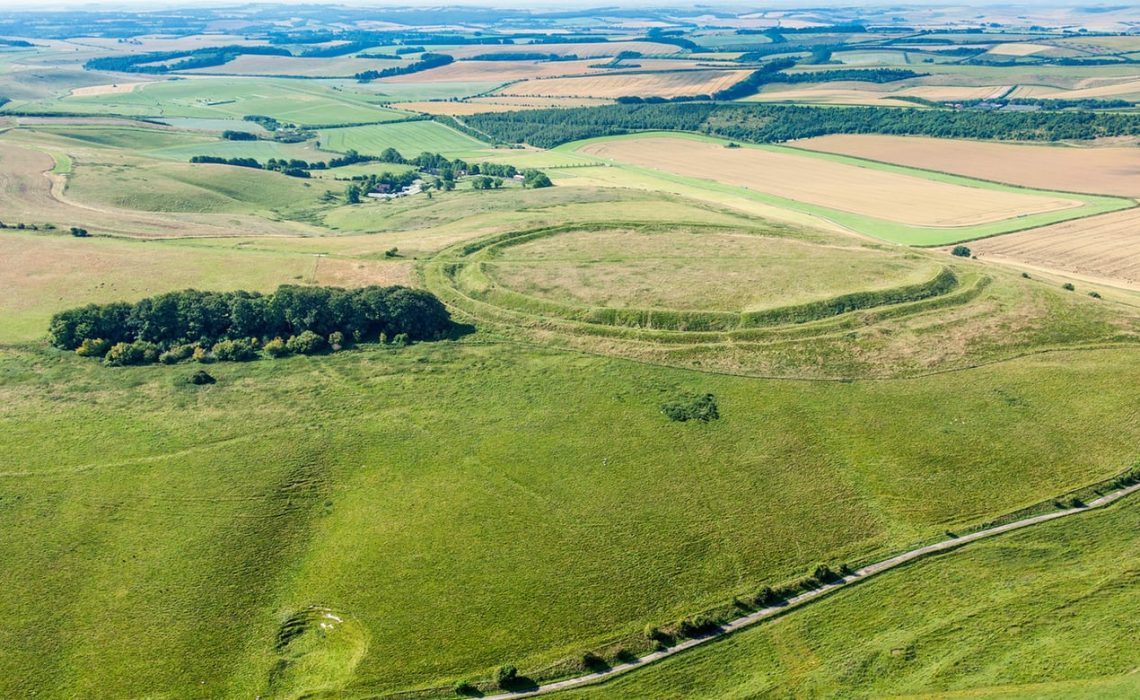
You might also like:
They stand in a clear line along the Wiltshire Downs facing north: perhaps facing an enemy whose identity we do not know. In the bright sunshine of late spring, I could see the hillforts stretching away along the escarpment – Barbury, then Liddington, and finally Uffington, with its famous chalk white horse. They may have been begun in the bronze age, but reached their apogee in the iron age, in the first millennium BC.
As a nation, we’re not very good at appreciating our prehistory. We can just about take in Stonehenge, but prefer our history to start with the Romans – more manageable and all written down.
Perhaps it’s the time I spent in Peru exploring its pre-Columbian past that led to my fascination with Britain’s iron age hillforts. But until now, it has not been shared. On the long walks I’ve done in the past few years – 400 miles across southern England from Dorset to Norfolk and, more recently, 200 miles across the north – almost all the hillforts were completely empty. The only people who used them regularly seemed to be dog walkers – perhaps because there’s usually a car park and they make a perfect constitutional canine circuit: once round the earthworks and no need to scoop.
But that may be about to change. This summer sees the launch of a new website dedicated to finding and exploring the UK’s numerous hillforts, coordinated by the universities of Edinburgh and Oxford. With the help of the public, they have created a database of over 4,000 hillforts across Britain and Ireland, which will make these sites far more accessible.
Some have survived better than others. Barbury is one of the best-preserved, with impressive ditches and double ramparts. Their purpose seems clear: defensively sited on the northern slopes of the downs, the better to aim slingshots at enemies, and with space inside for an entire village to shelter.
It is far from clear that “hillforts” were all primarily military: some, like Maiden Castle in Dorset, are too large and may also have been places of congregation and prestige. More may have been like iron age “community centres” – although that doesn’t sound so exciting.

Long after its use (or not) as a fort, Barbury was the location of one of the most significant (yet forgotten) battles in British history. In 556AD, Cynric, leader of the West Saxons, fought a decisive engagement with the Britons at Barbury Castle. The Britons were defeated and the Saxons went on to create Wessex, enslaving many of the remaining Britons.
It is almost too cinematic to be true, given that the hillfort had probably been built a good 1,000 years before the battle – as if a climactic episode of the second world war took place at Agincourt, or a machine-gun battle inside Rome’s Colosseum.
I arrived on a beautiful, crisp morning. The trackway from Avebury curled around the hills, lined with cranesbill and elderflower. There was a wind in the trees. Just walking round the earthworks took a while: they enclose some 13 acres. The line of the downs turns here from north to east, and in doing so opens up views in every direction; Barbury Castle is on the precise point of the turn.
I became conscious of the incessant calling of rooks from the stand of trees beside the castle. Iron age man was obsessed with these birds. Archaeologists have often found rooks and ravens, the largest of the corvids, buried at hillforts alongside humans.

What made them so fascinating to prehistoric man? The raven has always been a creature of myth, for its intelligence, longevity (living 25-40 years, Tennyson’s “many-winter’d crow” had the life expectancy of any human in the iron age) and capacity to mimic or follow human behaviour. But not necessarily for its loyalty – a raven is not like a dog. Corvids are cunning, and capable of stealing from an iron age camp.
In ancient Europe, from Greece to Celtic Britain, raven calls were thought to be messages from the underworld. One can see how: that “caw” has the rasp of death – and prophecy. Apollo is said to have listened to the utterances of a raven. The Celtic raven god, Lugh, was told by his fellow ravens when enemies approached. In Celtic mythology, ravens were one of the creatures thought to be used by shape-shifters, themselves often old women dressed in black rags, known as Morríghan or harridans. Some ravens may have been domesticated by their Druid handlers, like the ravens at the Tower of London today. It would be an arresting sight, the priest with a large raven on his shoulder; for they are large birds, bigger than buzzards. (Such an image has been found at Moux in southern France, as a Gallo-Roman stone relief.)

But above all, iron age man practised what modern Parsees call “sky burials” and archaeologists, more ponderously, “excarnation”: the exposure of a corpse on a platform or hill so that the bones can be picked clean by scavenging birds, of which the raven would be the largest and most predominant. Only then would the bones be buried, sometimes with some of the birds. There has been academic speculation that at the time of death the Druids may even have summoned the ravens with a special call, much as vultures are summoned by Parsee priests.
As I stood on Barbury Castle, whose own bones have been picked clean by time to reveal the bare stones of ditch and rampart, and with the ravens calling in my ears, I reflected on how rich and strange the iron age hillforts are. And how little, until now, we have appreciated them.
Sоurсе: theguardian.com
